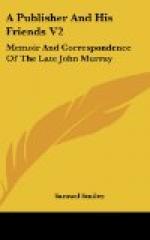urges Scott to visit London,
letter to Stratford Canning,
exertions to procure contributors,
Mrs. Rundell’s “Domestic Cookery,”
close alliance with Ballantyne,
Grahame’s “British Georgies” and Scott’s “English Ministrelsy,”
financial difficulties with Ballantyne,
letter from Campbell on “Selection from British Poets,”
Campbell’s Gertrude of “Wyoming,”
1810—Breach with Ballantyne,
appoints W. Blackwood his agent in Scotland,
Southey’s “Life of Nelson,”
money difficulties—Ballantyne’s bills,
transfers printing business,
Constable’s bills,
decrease in circulation of Q.R.,
1811—Relations with Gifford,
improvement of Q.R.,
generosity to Gifford,
origin of his connection with Byron,
“Childe Harold,”
1812—Ballantyne’s bills again,
purchases stock of Miller,
of Albemarle Street,
removes to Albemarle Street,
Constable’s bills,
final breach with Constable,
complete success of Q.R.
refuses “The Rejected Addresses,”
1813—“The Giaour,” and “The Bride of Abydos,”
Sir J. Malcolm,
I. D’Israeli’s “Calamities of Authors,”
Scott’s bill transactions,
Mme. de Stael at Albemarle Street,
other books published by him during the year,
1814—“The Corsair,”
“Ode to Napoleon,”
“Lara and Jacqueline,”
Mrs. Murray’s visit to Leith,
letters to Mrs. Murray,
visit from Blackwood,
dines with I. D’Israeli,
education of his son John,
visit to D’Israeli at Brighton,
description of Newstead Abbey,
Byron’s skull-cup,
trip to Edinburgh,
alliance with Blackwood,
visit to Abbotsford,
shares in Scott’s “Don Roderick,”
correspondence with Coleridge,
1815—Drawing-room in Albemarle Street,
Mme. de Stael,
first meeting of Scott and Byron,
Napoleon’s escape from Elba,
sends first news of Battle of Waterloo to Blackwood,
literary parties,
portraits of distinguished men,
trip to Paris,
Scott’s proposed letters from the Continent,
Napoleon’s personal correspondence with crowned heads, etc., of
Europe,
publishes Miss Austen’s “Emma,”
begins to publish Malthus’ works,
correspondence with Leigh Hunt as to the “Story of Rimini,”
correspondence with James Hogg,
dealings with Byron,
his liberal offer to Byron,
“Siege of Corinth” and “Parisina,”
remonstrates with Byron,
correspondence with Blackwood,
other books published by him during the year,
1816—Kindness to Rev. C.R. Maturin,
Coleridge’s “Glycine: a Song,” “Remorse,” “Zapolya,” “Christabel,”
and “Christmas Tale,”
correspondence with Leigh Hunt,
letter to Stratford Canning,
exertions to procure contributors,
Mrs. Rundell’s “Domestic Cookery,”
close alliance with Ballantyne,
Grahame’s “British Georgies” and Scott’s “English Ministrelsy,”
financial difficulties with Ballantyne,
letter from Campbell on “Selection from British Poets,”
Campbell’s Gertrude of “Wyoming,”
1810—Breach with Ballantyne,
appoints W. Blackwood his agent in Scotland,
Southey’s “Life of Nelson,”
money difficulties—Ballantyne’s bills,
transfers printing business,
Constable’s bills,
decrease in circulation of Q.R.,
1811—Relations with Gifford,
improvement of Q.R.,
generosity to Gifford,
origin of his connection with Byron,
“Childe Harold,”
1812—Ballantyne’s bills again,
purchases stock of Miller,
of Albemarle Street,
removes to Albemarle Street,
Constable’s bills,
final breach with Constable,
complete success of Q.R.
refuses “The Rejected Addresses,”
1813—“The Giaour,” and “The Bride of Abydos,”
Sir J. Malcolm,
I. D’Israeli’s “Calamities of Authors,”
Scott’s bill transactions,
Mme. de Stael at Albemarle Street,
other books published by him during the year,
1814—“The Corsair,”
“Ode to Napoleon,”
“Lara and Jacqueline,”
Mrs. Murray’s visit to Leith,
letters to Mrs. Murray,
visit from Blackwood,
dines with I. D’Israeli,
education of his son John,
visit to D’Israeli at Brighton,
description of Newstead Abbey,
Byron’s skull-cup,
trip to Edinburgh,
alliance with Blackwood,
visit to Abbotsford,
shares in Scott’s “Don Roderick,”
correspondence with Coleridge,
1815—Drawing-room in Albemarle Street,
Mme. de Stael,
first meeting of Scott and Byron,
Napoleon’s escape from Elba,
sends first news of Battle of Waterloo to Blackwood,
literary parties,
portraits of distinguished men,
trip to Paris,
Scott’s proposed letters from the Continent,
Napoleon’s personal correspondence with crowned heads, etc., of
Europe,
publishes Miss Austen’s “Emma,”
begins to publish Malthus’ works,
correspondence with Leigh Hunt as to the “Story of Rimini,”
correspondence with James Hogg,
dealings with Byron,
his liberal offer to Byron,
“Siege of Corinth” and “Parisina,”
remonstrates with Byron,
correspondence with Blackwood,
other books published by him during the year,
1816—Kindness to Rev. C.R. Maturin,
Coleridge’s “Glycine: a Song,” “Remorse,” “Zapolya,” “Christabel,”
and “Christmas Tale,”
correspondence with Leigh Hunt,




